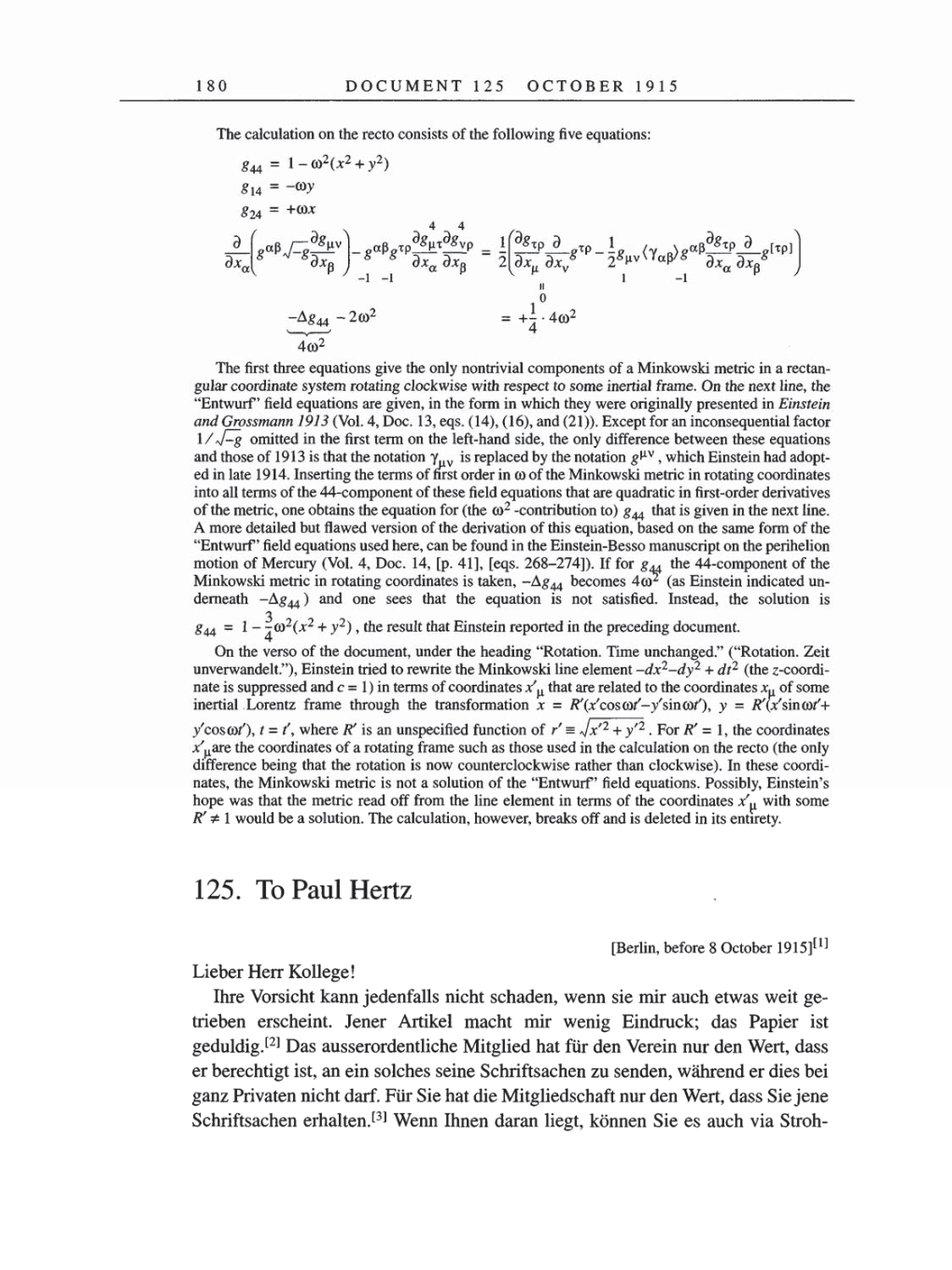180
DOCUMENT 125 OCTOBER 1915
The calculation
on
the
recto
consists
of
the
following
five
equations:
#44 =
1
-
*2(x2
+
y2)
8
U
=
_9
dx.
g24 =
+C0*
'g°»J=¿dg'UV
dxo
p^Ut^vp
dxa
dxß
^IPjLgxp
_
dx^ dxv
ii
.
0
2^uv
Ya
^8ip
9
dxa
dXa
jUp]
-2co2
=
+7
•
4co2
4
The first three
equations
give
the
only
nontrivial
components
of
a
Minkowski metric in
a
rectan-
gular
coordinate
system
rotating
clockwise with
respect to some
inertial frame. On the next
line, the
“Entwurf” field
equations
are given,
in the
form
in which
they were originally
presented
in
Einstein
and
Grossmann 1913
(Vol. 4,
Doc.
13, eqs. (14), (16),
and
(21)). Except
for
an inconsequential
factor
1/7-g
omitted in
the
first
term
on
the
left-hand
side,
the
only
difference
between
these
equations
and
those
of
1913 is
that
the notation
y
is
replaced
by
the
notation gPv,
which Einstein
had
adopt-
ed in late 1914.
Inserting
the
terms
of
first order in
co
of
the
Minkowski
metric
in
rotating
coordinates
into
all terms
of the
44-component
of
these field
equations
that
are
quadratic
in first-order derivatives
of
the
metric, one
obtains the
equation
for
(the to2
-contribution
to)
that is
given
in the
next
line.
A
more
detailed
but
flawed version
of
the
derivation
of
this
equation,
based
on
the
same
form
of
the
“Entwurf” field equations used
here,
can
be found in the Einstein-Besso
manuscript
on
the
perihelion
motion
of
Mercury
(Vol. 4,
Doc.
14,
[p.
41],
[eqs.
268-274]).
If for
g^
the
44-component
of
the
Minkowski metric in
rotating
coordinates is
taken,
-Ag^ becomes 4co2
(as
Einstein
indicated
un-
derneath
-A£44
)
and
one sees
that the
equation
is not satisfied.
Instead,
the solution is
g44 =
1
-
-(ü2(x2 +
y1),
the result that Einstein
reported
in the
preceding
document.
On the
verso
of
the
document,
under the
heading
“Rotation. Time
unchanged.”
(“Rotation.
Zeit
unverwandelt.”),
Einstein
tried to rewrite the Minkowski line element
-dx2-dy2 +
dt2
(the
z-coordi-
nate is
suppressed
and
c
=
1)
in terms
of
coordinates
x'u
that
are
related
to
the coordinates
xu
of
some
inertial Lorentz
frame
through
the
transformation
x
=
R'(x'coswt'-y'sinwt'),
y
=
R'(x'sincot'+
y'coscoí'),
t
=
t’,
where R'
is
an unspecified
function of
r'
=
Jx'2
+ y'2.
For
R'
=
1,
the coordinates
x'^are
the coordinates
of
a rotating
frame such
as
those used in the calculation
on
the recto
(the only
difference
being
that
the
rotation is
now
counterclockwise
rather than
clockwise).
In these coordi-
nates,
the Minkowski metric is not
a
solution
of
the “Entwurf” field
equations. Possibly,
Einstein’s
hope was
that the metric read
off from
the line
element
in terms
of
the
coordinates
x'^
with
some
R'
#
1
would be
a
solution. The
calculation, however,
breaks off
and
is
deleted
in its
entirety.
125. To
Paul Hertz
[Berlin,
before
8
October
1915][1]
Lieber Herr
Kollege!
Ihre Vorsicht
kann
jedenfalls
nicht
schaden, wenn
sie
mir
auch
etwas
weit
ge-
trieben erscheint.
Jener
Artikel macht
mir
wenig
Eindruck;
das
Papier
ist
geduldig.[2]
Das ausserordentliche
Mitglied
hat
für
den Verein
nur
den
Wert,
dass
er berechtigt ist, an
ein solches seine Schriftsachen
zu
senden,
während
er
dies bei
ganz
Privaten
nicht
darf.
Für
Sie
hat
die
Mitgliedschaft nur
den
Wert,
dass Sie
jene
Schriftsachen erhalten.[3] Wenn Ihnen
daran
liegt,
können Sie
es
auch
via
Stroh–
